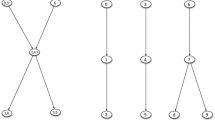Abstract
For a finite ordered set P, let c(P) denote the cardinality of the largest subset Q such that the induced suborder on Q satisfies the Jordan-Dedekind chain condition (JDCC), i.e., every maximal chain in Q has the same cardinality. For positive integers n, let f(n) be the minimum of c(P) over all ordered sets P of cardinality n. We prove: \(\sqrt {2n } - 1 \leqslant f (n) \leqslant 4 e \sqrt {n.}\)
Similar content being viewed by others
References
R. P.Dilworth (1950) A decomposition theorem for partially ordered sets, Ann. Math. 51, 161–166.
P.Erdös and J.Spencer (1974) Probabilistic Methods in Combinatorics, Akadés Kiadós, Budapest.
C.Greene (1974) An extension of Schensted's Theorem, Adv. Math. 14, 254–265.
C.Schensted (1961) Longest increasing and decreasing subsequences, Can. J. Math. 13, 179–191.
Author information
Authors and Affiliations
Additional information
Communicated by D. Duffus
Rights and permissions
About this article
Cite this article
Linial, N., Saks, M. & Shor, P. Largest induced suborders satisfying the chain condition. Order 2, 265–268 (1985). https://doi.org/10.1007/BF00333132
Received:
Accepted:
Issue Date:
DOI: https://doi.org/10.1007/BF00333132



